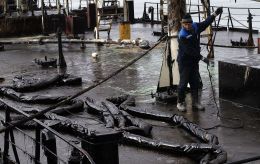Venice, London, Miami at risk: Scientists name cities that may be submerged soon
 Which cities will go underwater due to melting glaciers (photo: Getty Images)
Which cities will go underwater due to melting glaciers (photo: Getty Images)
A new study by scientists from Sorbonne University (Paris) warns of catastrophic and irreversible consequences for the world's coastal cities. In less than 300 years, dozens of cities in the US, the UK, and across Europe could disappear from the face of the Earth. Nature explains why a global catastrophe could occur and which cities may go underwater.
According to scientists, if greenhouse gas emissions remain high, up to 59% of Antarctica's ice shelves could collapse by the year 2300, leading to a sea level rise of as much as 10 meters.
Glaciers as a protective barrier
Antarctica contains 15 large and many smaller ice shelves. These floating extensions of the Antarctic ice sheet are critical in regulating ice loss.
"Since they hold back the flow of ice from the grounded ice sheet into the ocean through what's known as buttressing, they form a protective belt around Antarctica," explain researchers led by Clara Burgard.
The thinning and subsequent collapse of these ice shelves therefore accelerates the flow of ice into the ocean, which in turn causes significant sea level rise.
Two scenarios: From one to 38 disappearing glaciers
The team of scientists conducted simulations to assess how changes in emissions would affect the melting of 64 key ice shelves. The results highlight a direct link between decisions made today and the fate of the planet:
- If emissions remain low by 2300 (below 2 degrees), only 1 out of 64 ice shelves will be at risk, and the sea level rise will be minimal.
- If emissions are high and reach 12 degrees, 38 ice shelves (59%) will be at risk, and the sea level could rise by as much as 10 meters.
The researchers emphasize that the viability of ice shelves is highly dependent on emission scenarios, since only one ice shelf becomes likely or very likely unviable by 2300 under the low-emission scenario, compared to 59% under the high-emission scenario.
Irreversible consequences will come sooner
Although the year 2300 seems far away, scientists warn that we will begin to feel the consequences much earlier.
The researchers explain that the period roughly between 2085 and 2170 marks the time when the highest number of ice shelves will likely reach the point of unviability.
At the same time, they describe their assessment as "conservative," since actual collapse could occur sooner depending on the vulnerability of specific ice shelves to processes such as hydrofracturing or crack formation.
Threat to the world's megacities
If the sea level rises by 10 meters (32 feet), entire cities and vast coastal areas will be submerged, according to the Climate Central Coastal Risk Screening Tool:
United Kingdom
The following will go underwater:
- Hull
- Glasgow
- Bristol
- Portsmouth
- Southend-on-Sea
- Middlesbrough
Large parts of London along the Thames (including Hammersmith, Greenwich, Southwark, and Westminster) will also be flooded.
United States
Residents will be forced to relocate from:
- Houston
- New Orleans
- Miami
All coastal areas of Florida, Louisiana, and Texas will be at risk.
Europe
The following areas will go underwater:
- The entire coastline from Calais (France) to Ringkøbing (Denmark)
Venice, Montpellier, Seville, and Lisbon will also be affected.
Asia
Flooding threatens:
- A significant part of Bangladesh
- Shanghai
- Ho Chi Minh City
- Karachi
The researchers emphasize that their findings aim to underscore the pressing need for action to mitigate greenhouse gas emissions, as current choices could greatly influence the long-term likelihood of losing most Antarctic ice shelves.

